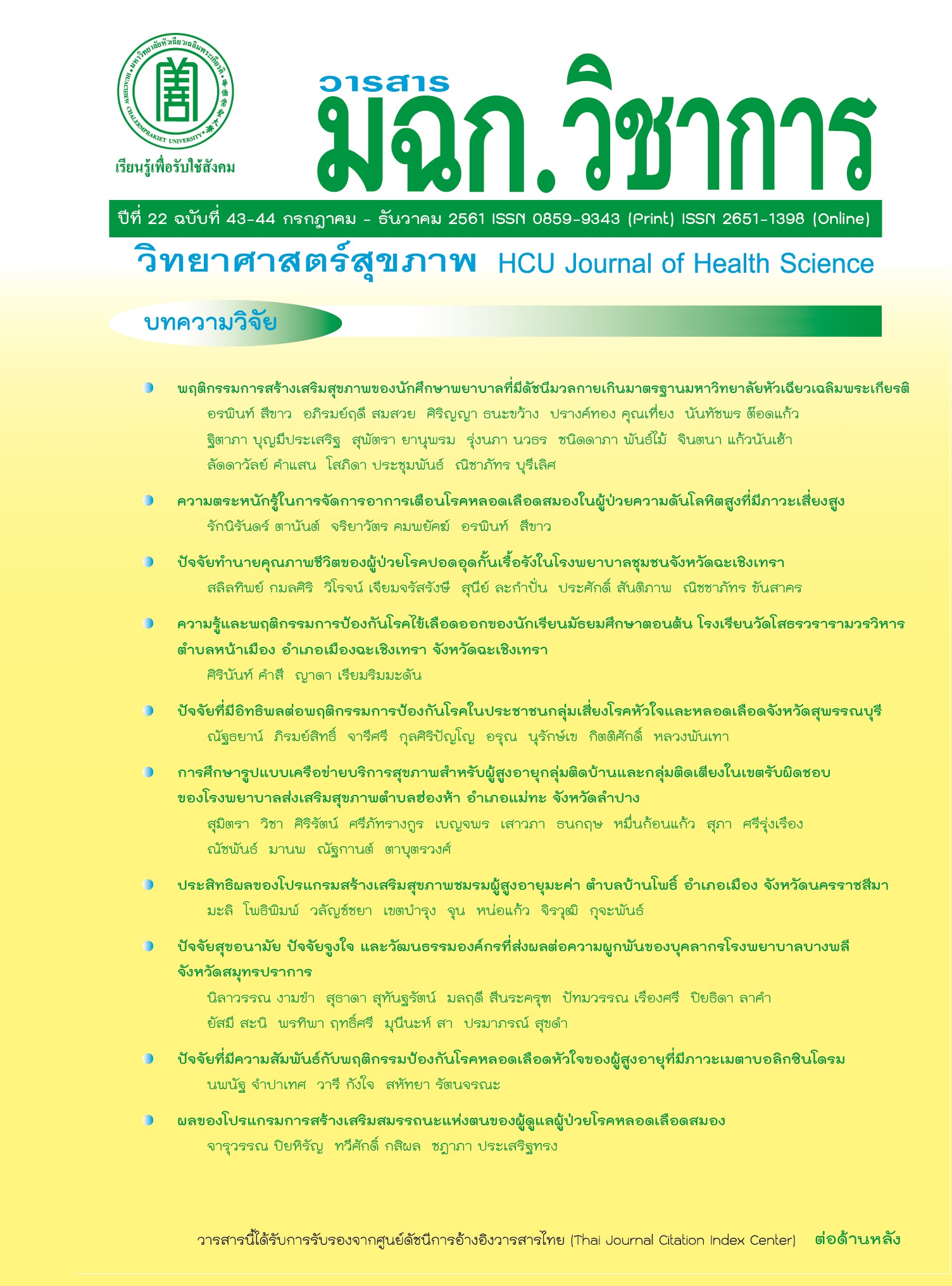Knowledge and Preventive Behaviors for Dengue Hemorrhagic Fever Among Secondary School Students, Watsothonwararamworawiharn School, Na Muang Sub-district, Muang Chachoengsao District, Chachoengsao Province
Keywords:
Knowledge of dengue fever, preventive behaviors, studentsAbstract
The objective of this research was to study the knowledge and behavior that could prevent dengue hemorrhagic fever among secondary school students, at Watsothonwararamworawiharn school, Na Mueang sub-district Chachoengsao district Chachoengsao province. Research and the samples was specifically selected from 200 secondary school students of the academic year 2006. The questionnaire was used as a tool to collect data using the alpha coefficient of Cronbach with a confidence value equal to 0.69. The statistics used in data analysis were percentage, mean and standard deviation.
The results showed that students had knowledge about dengue fever in the medium level (0.57±0.43) and preventive behaviors in the medium level (2.16±0.44) and the knowledge about dengue fever was associated with dengue fever prevention behavior at a statistically significant level (r=-0.21;p<0.01). However, during the outbreak of dengue fever in the area, the age group 10-of 14 year had high morbidity rates. The results of this study pointed to the need to inform students of all ages with knowledge about the diseases of the poor including the causes of dengue fever disease, mosquito larvae breeding grounds and mosquito bites duration. This may result in moderate knowledge preventive and behavior toward dengue hemorrhagic fever.
Downloads
References
2. Guo C, Zhou Z, Wen Z. Global epidemiology of dengue outbreaks in 1990–2015: A systematic review and meta-analysis. Front Cell Infect Microbiology. 2017;7:317.
3. กระทรวงสาธารณสุข สำนักโรคติดต่อที่นำโดยแมลง. สถานการณ์โรคไข้เลือดออกในประเทศไทยปี [อินเทอร์เน็ต]. 2558. [เข้าถึงเมื่อ 6 มกราคม 2558 ]. เข้าถึงจาก: http://www.thaivbd.org /n/uploads/file/file_PDF/Dengue/2559 /DHF%2048.pdf
4. สำนักงานสาธารณสุขจังหวัดฉะเชิงเทรา กลุ่มงานควบคุมโรค. รายงานการเฝ้าระวังทางระบาดวิทยา [อินเทอร์เน็ต]. 2559. [เข้าถึงเมื่อ 6 มกราคม 2560]. เข้าถึงจาก: http://www.cco.moph.go.th /cco24/5.2_1.pdf
5. บุญธรรม กิจปรีดาบริสุทธิ์. สถิติวิเคราะหเพื่อการวิจัย. พิมพครั้งที่4. กรุงเทพมหานคร: จามจุรีโปรดักท ; 2549.
6. วิเชียร เกตุสิงห์. ค่าเฉลี่ยและการแปลความหมาย. ข่าวสารวิจัยทางการศึกษา. 2538;8(3)8-11.
7. Suwanbamrung C, Promsupa S, Doungsin T, Tongjan S. Risk factors related to dengue infections inprimary school students: Exploring students’ basic knowledge of dengue and examining the larval indices in southern Thailand. Infect Public Health. 2013;6,347-57.
8. สุรพงษ โสธนะเสถียร. แนวคิดและทฤษฎีเกี่ยวกับความรูทัศนคติและพฤติกรรม [อินเทอร์เน็ต]. 2533 [เข้าถึงเมื่อ 10 เมษายน 2558]. เข้าถึงจาก: http://www.Novabizz.com/NovaAce/Attitude.htm
9. จรัสศรี วันเพ็ญ. ปัจจัยที่เกี่ยวข้องกับพฤติกรรมการป้องกันโรคไข้เลือดออกของนักเรียนมัธยมศึกษาตอนต้น จังหวัดปทุมธานี. [วิทยานิพนธ์]. กรุงเทพมหานคร: มหาวิทยาลัยเกษตรศาสตร์; 2550.
10. กุลนิดา ยารวง. การศึกษาปัจจัยที่มีผลต่อพฤติกรรมการป้องกันและควบคุมโรคไข้เลือดออกของประชาชนในตำบลแม่สาย อำเภอแม่สาย จังหวัดเชียงราย. [วิทยานิพนธ์]. พะเยา: มหาวิทยาลัยพะเยา; 2555.
11. Harapan H, Rajamoorthy Y, Anwar S, Bustamam A, Radiansyah A, Angraini P,et al., Knowledge, attitude, and practice regarding dengue virus infection among inhabitants of Aceh, Indonesia: a cross-sectional study. BMC Infectious Disease. 2018;18(1):96.
12. Udayanga L, Gunathilaka N, Iqbal MCM, Pahalagedara K, Amarasinghe US, Abeyewickreme W. Socio-economic, knowledge attitude practices (KAP), household related and demographic based appearance of non-dengue infected individuals in high dengue risk areas of Kandy District, Sri Lanka. BMC Infectious Diseases. 2018;18:88.
Downloads
Published
How to Cite
Issue
Section
License
บทความที่ได้รับการตีพิมพ์เป็นลิขสิทธิ์ของวารสารวิทยาศาสตร์สุขภาพและสุขภาวะ
ข้อความที่ปรากฏในบทความแต่ละเรื่องในวารสารวิชาการเล่มนี้เป็นความคิดเห็นส่วนตัวของผู้เขียนแต่ละท่านไม่เกี่ยวข้องกับมหาวิทยาลัยหัวเฉียวเฉลิมพระเกียรติ และคณาจารย์ท่านอื่นๆในมหาวิทยาลัยฯ แต่อย่างใด ความรับผิดชอบองค์ประกอบทั้งหมดของบทความแต่ละเรื่องเป็นของผู้เขียนแต่ละท่าน หากมีความผิดพลาดใดๆ ผู้เขียนแต่ละท่านจะรับผิดชอบบทความของตนเองแต่ผู้เดียว




